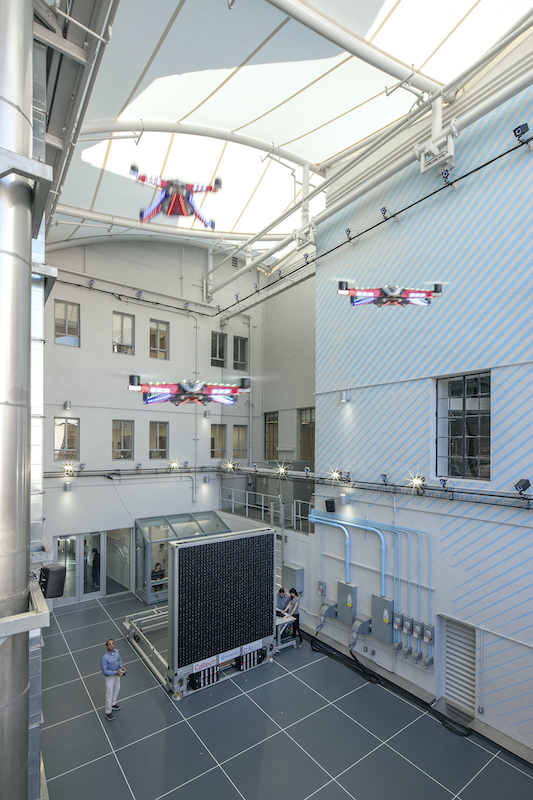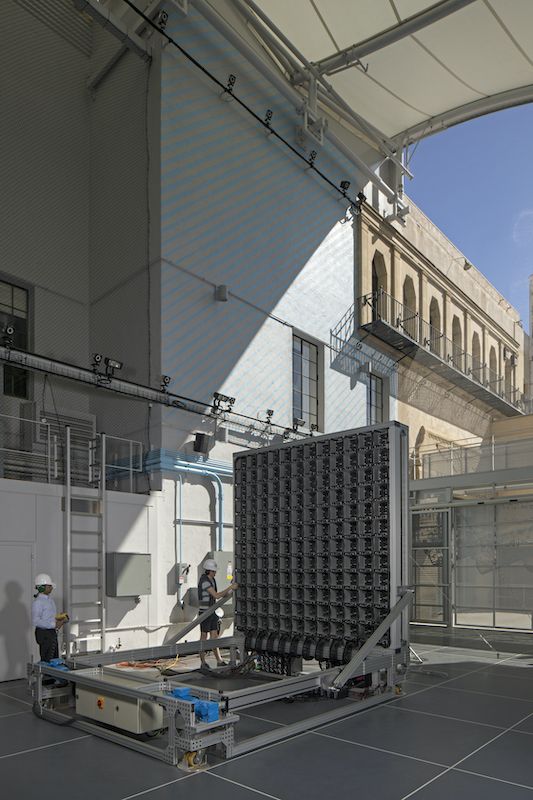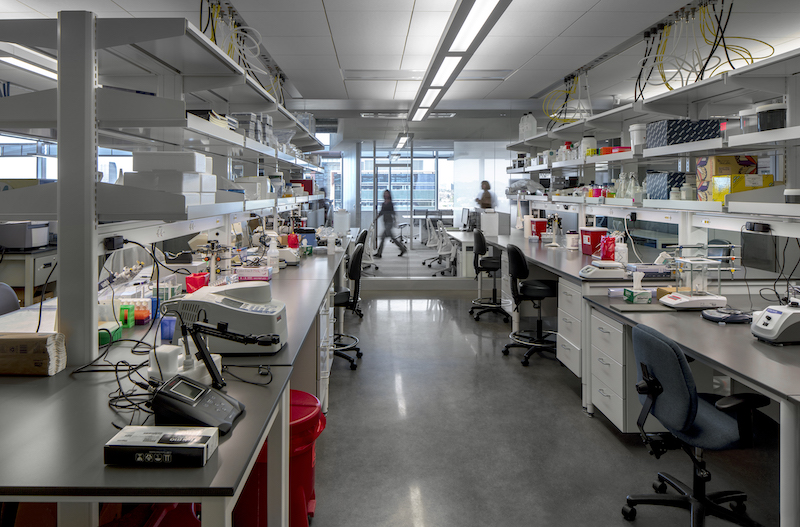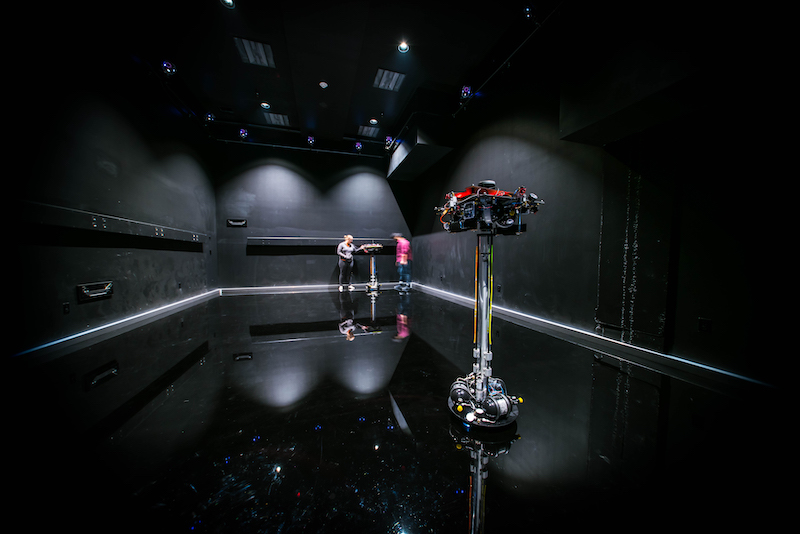When Andrew Labov began his career with CO Architects in 1987, it wasn’t all that rare for universities to customize their labs for specific users. But over the years the cost of construction and renovation became prohibitive, so universities made their lab spaces as flexible as possible.
More recently, customization has been making a comeback, partly out of necessity as research universities vie for top students and high-profile faculty. CO Architects, which is based in Los Angeles, has cultivated this specialty, thanks, explains Labov, FAIA, LEED AP, a Principal with the firm, to the “proliferation” of inexpensive research equipment, coupled with the trend in science toward “conversion,” where disciplines overlap. (Bioengineering was one of the first hybrids.)
Among the research universities for which CO Architects has designed labs to accommodate this trend are the University of Texas in Austin, the University of Southern California, and the University of California at San Diego.
Since 2013, CO Architects has delivered a series of highly customized lab renovations and office interior fitouts for the California Institute of Technology (Caltech) in Pasadena, several of which conformed with the criteria of individual researchers.
The firm developed 1,200 sf of lab space for Assistant Professor of Computer and Mathematical Sciences Katie Bouman, who is best known for having captured the first images of a black hole. That space combined a computer science lab and photo studio, with a neutral area that synthesizes the two.
Other “designer” labs at Caltech include the 3,318-sf Shapiro Lab that supports the work of Assistant Professor of Chemical Engineering Mikhail Shapiro and his team that develops molecular technologies to image and control the function of cells in order to study nervous system function and diseases. CO Architects also renovated a 8,500-sf lab and office space for Assistant Professor of Biology Yuki Oka and Betty Hong, the Clare Boothe Luce Assistant Professor of Neuroscience at Caltech’s biology and bioengineering division. This project featured a main lab, modernized dark room, a new CITnet room, animal research lab, and BBE equipment room.
Also see: Renovation can turn older university buildings into high-performing labs

CAST Lab at California Institute of Technology tests autonomous systems like drones under natural and simulated environmental conditions. Image: Tom Bonner
At a time when universities are receiving less federal funding, customizing labs allows schools to monetize their spaces by bringing in industry partners. For example, in 2015 CO Architects designed the renovation of a World War II-era engineering research building at Caltech for the 6,650-sf Space Solar Power Initiative, which launched with a $17.5 million grant from Northrup Grumman. This lab suite accommodates a range of activities, including assembly and structures integration areas, chemistry and optics labs, and conference and meeting rooms.
Among CO’s more ambitious customized lab projects has been The Center for Autonomous Systems Technology (CAST Lab) that investigates the peaceful use of smart machines like drones and robots. The Center includes a three-story-tall testing area and observation deck.
Labov notes that because CAST Lab was testing mockups of satellites in zero-gravity environments, its floor had to be completely flat (this is only the second lab with that feature built in the U.S.). CO worked with a contractor out of Georgia that had developed a liquid-resin floor for the race-car industry. “You couldn’t even write specs for the lab, because there weren’t any,” Labov says.
CAST Lab also has the world’s first outdoor wind tunnel with a specialized wall that includes 1,200 small fans. This space is set up to “teach” drones to fly autonomously in windy conditions.

CAST Lab features the world's first outdoor wind tunnel. Image: Tom Bonner
LISTENING TO AND LEARNING FROM EXPERTS
To design CAST Lab, CO Architects met with professors on a weekly basis. “This was the most hands-on project with a client I’ve ever worked on,” says Jennifer Swedell, AIA, LEED BD+C, NOMA, an Associate Principal at CO Architects. Swedell says that the firm’s expertise in the sciences ranges from “none to some.” So designers need to be open minded, and ask a lot of questions. “It’s almost like an R&D project,” she observes.
A few years ago, CO Architects did a fitout of half a floor—around 6,000 sf—inside a biomedical building at the University of Arizona for Frederic Zenhausern, Director of the Center for Applied NanoBioscience and Medicine. Labov recalls that the lab had to be designed without knowing specifically who the users were. (Zenhausern concedes that his 20-person team is “unconventional” and “diverse” in its activities.) Labov explains that the space needed to accommodate teams for cancer research, public health, and other disciplines, based on the funding the school was pursuing. On top of that, the building hadn’t been renovated in more than 70 years.
Labov says the floor’s corridor was designed with a utility “backbone,” and included several empty mechanical shafts for exhaust. So by the time Zenhausern came in, “we had to make very few modifications.” Zenhausern says it took his team and CO about a year to arrive at a design both were satisfied with. The actual fitout didn’t take that long to complete. “We had a complete inventory of equipment and the specs for all the instruments. We had a good relationship with CO during the back and forth.”
Labov notes that even if a researcher for whom a lab is designed leaves the university, the space's “backbone” is flexible enough “so it can plug and play systems for any type of research or activity.”
Also see: Academic labs are opening back up. Still research isn’t exactly back to normal
Robots being tested at CAST Lab, whose floor is completely flat, only one of two labs in the U.S. with that feature. Image: Caltech
AEC FIRMS MIGHT BENEFIT FROM EDUCATION ABOUT SCIENCE AND REGS
CO Architects’ latest foray into customized lab design is a “Good Manufacturing Practices” (GMP) lab for the USC School of Medicine and Children's Hospital in downtown L.A. GMP is a Food and Drug Administration term describing immunotherapy to combat cancer. When completed, the lab will produce and purify large quantities of prospective drugs while retaining quality for the translation of drug discovery to clinical trials.
For this project, CO consulted with Gerhard Bauer, Director of the GMP Facility and professor of hematology and oncology for the School of Medicine at the University of California-Davis Institute for Regenerative Cures in Sacramento. Bauer says that since 1996, he’s advised on or helped build at least 16 GMP projects worldwide.
During that stretch, he’s worked with several architectural firms, each with its own approach to projects. “Architects all think in a certain way, and I can speak their language,” says Bauer. When disagreements arise, he can make his argument from “the technical, scientific, and code sides. Plus, I’ve done so many of these” that the firms respect his opinions.
Some of the breakthroughs in GMP design he’s been part of, he says, is “switchable manufacturing room pressurization,” which solves the potential danger of cross-contamination in gene therapy production by using a robust air-return system that has up to 60 air exchanges per minute.
UC Davis’ innovation center, in partnership with outside companies, has also incubated a larger-scale manufacturing facility that focuses on curing different types of cancers beyond hematologic cells.
Bauer acknowledges that regulations for GMPs are “vague,” which is why he thinks the AEC industry would benefit from educational classes “to help them maneuver through the regulatory jungle and understand the science.”
Related Stories
Laboratories | Oct 23, 2024
From sterile to stimulating: The rise of community-centric life sciences campuses
To distinguish their life sciences campuses, developers are partnering with architectural and design firms to reimagine life sciences facilities as vibrant, welcoming destinations. By emphasizing four key elements—wellness, collaboration, biophilic design, and community integration—they are setting their properties apart.
Laboratories | Oct 2, 2024
Trends in scientific research environments: Q&A with Flad's Matt McCord
As part of an ongoing series, Matt McCord, AIA, NCARB, LEED AP BD+C, Associate Principal with Flad Architects, discusses the future of the scientific workplace.
Laboratories | Sep 27, 2024
Traditional lab design doesn't address neurodiverse needs, study finds
A study conducted by ARC, HOK, and the University of the West of Scotland, has revealed that half (48.1%) of all survey respondents who work in laboratory settings identify as neurodivergent.
Laboratories | Sep 26, 2024
BSL conversions: A cost-efficient method to support high-containment research
Some institutions are creating flexible lab spaces that can operate at a BSL-2 and modulate up to a BSL-3 when the need arises. Here are key aspects to consider when accommodating a rapid modulation between BSL-2 and BSL-3 space.
Higher Education | Sep 18, 2024
Modernizing dental schools: The intersection of design and education
Page's John Smith and Jennifer Amster share the how firm's approach to dental education facilities builds on the success of evidence-based design techniques pioneered in the healthcare built environment.
Great Solutions | Jul 23, 2024
41 Great Solutions for architects, engineers, and contractors
AI ChatBots, ambient computing, floating MRIs, low-carbon cement, sunshine on demand, next-generation top-down construction. These and 35 other innovations make up our 2024 Great Solutions Report, which highlights fresh ideas and innovations from leading architecture, engineering, and construction firms.
Laboratories | Jul 3, 2024
New science, old buildings: Renovating for efficiency, flexibility, and connection
What does the research space of the future look like? And can it be housed in older buildings—or does it require new construction?
Mass Timber | Jun 26, 2024
Oregon State University builds a first-of-its-kind mass timber research lab
In Corvallis, Oreg., the Jen-Hsun Huang and Lori Mills Huang Collaborative Innovation Complex at Oregon State University aims to achieve a distinction among the world’s experimental research labs: It will be the first all-mass-timber lab meeting rigorous vibration criteria (2000 micro-inches per second, or MIPS).
Healthcare Facilities | Jun 18, 2024
A healthcare simulation technology consultant can save time, money, and headaches
As the demand for skilled healthcare professionals continues to rise, healthcare simulation is playing an increasingly vital role in the skill development, compliance, and continuing education of the clinical workforce.
Laboratories | May 24, 2024
The Department of Energy breaks ground on the Princeton Plasma Innovation Center
In Princeton, N.J., the U.S. Department of Energy’s Princeton Plasma Physics Laboratory (PPPL) has broken ground on the Princeton Plasma Innovation Center (PPIC), a state-of-the-art office and laboratory building. Designed and constructed by SmithGroup, the $109.7 million facility will provide space for research supporting PPPL’s expanded mission into microelectronics, quantum sensors and devices, and sustainability sciences.


















